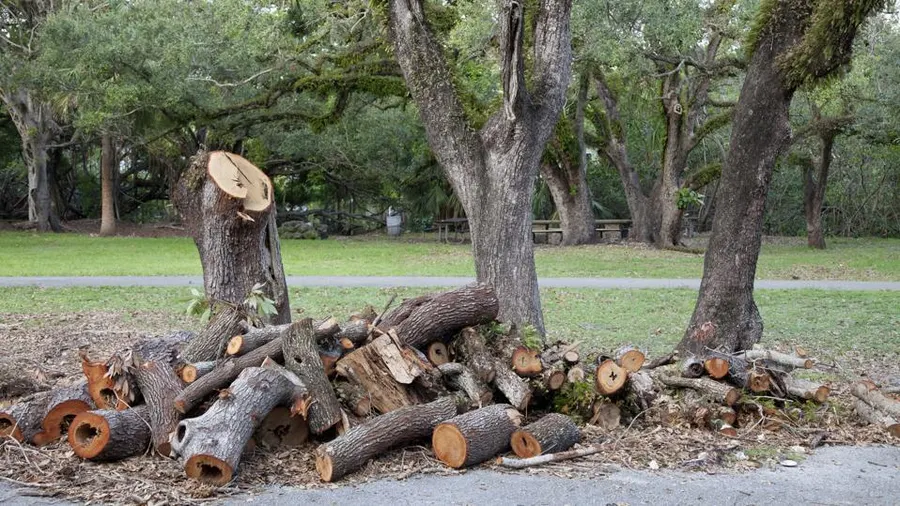The Price of Going Green: How Much Does It Cost to Cut Down a Tree?
Trees are majestic additions to our landscapes, providing shade, beauty, and environmental benefits. But sometimes, a tree can become a hazard, encroach on power lines, or simply outgrow its designated space. When faced with the decision to remove a tree, understanding the cost involved is crucial. This comprehensive guide explores the factors influencing tree removal costs and equips you with the knowledge to estimate the price for your specific situation.
Factors Affecting the Price of Tree Removal: A Branching Out Analysis
The cost of tree removal can vary significantly depending on several factors. Here’s a breakdown of the key elements that influence the price tag:
-
Tree Size: Unsurprisingly, the size of the tree is the most significant factor influencing cost. Larger trees require more time, labor, and potentially specialized equipment to remove safely. Here’s a general cost range based on tree size:
- Up to 30 feet tall: $150 – $500
- 30 – 60 feet tall: $200 – $1,000
- Over 60 feet tall: $1,000 – $2,000 or more
-
Tree Species: Certain tree species pose unique challenges for removal. For example, trees with dense wood or brittle branches might require extra care and specialized equipment, increasing the cost.
-
Tree Health and Condition: A healthy tree with a straight trunk is typically easier and less expensive to remove than a diseased, dead, or leaning tree. Diseased or decaying trees might necessitate additional safety precautions, impacting the price.
-
Location of the Tree: The location of the tree significantly influences the removal difficulty and cost. Trees close to buildings, power lines, or other structures require more careful planning and potentially specialized equipment, driving up the price. Easy access for removal crews also plays a role; removing a tree in a tight backyard space might be more expensive than one in an open field.
-
Removal Complexity: The complexity of the removal process affects the cost. Factors like the presence of power lines, intertwined branches with neighboring trees, or the need for specialized techniques like crane removal all contribute to a higher price tag.
-
Stump Removal: Tree removal often doesn’t include stump removal. Removing the stump requires additional grinding or excavation equipment and labor, adding to the overall cost. Decide whether stump removal is necessary for your landscaping needs.
-
Permits and Regulations: Local regulations might require permits for tree removal, especially for protected species or trees within certain zones. Factor in the potential cost of obtaining permits when budgeting for tree removal.
Remember: These are just general cost ranges. Obtaining quotes from several qualified arborists (tree care professionals) in your area is the best way to get an accurate estimate for your specific tree removal needs.
Beyond the Price Tag: Safety and Environmental Considerations
While cost is an important factor, safety and environmental considerations are equally important when removing a tree. Here’s why:
- Safety First: Tree removal can be risky. Hiring a qualified and insured arborist ensures the job is done safely and minimizes the risk of property damage or injury.
- Environmental Impact: Trees provide significant environmental benefits. If possible, explore tree trimming or alternative solutions before resorting to removal. Planting new trees to replace removed ones can help offset the environmental impact.
The Art of Negotiation: Getting the Best Price for Tree Removal
Once you have a few quotes from qualified arborists, consider these tips for negotiating the best price:
- Compare Estimates: Don’t settle for the first quote you receive. Compare pricing structures, proposed removal methods, and included services (like stump removal) from various arborists.
- Explain Your Needs: Clearly communicate your specific requirements, such as the desired outcome for the remaining stump and the timeline for removal.
- Inquire About Discounts: Ask arborists if they offer discounts for senior citizens, veterans, or multiple tree removals.
- Be Flexible: If possible, be flexible with the removal date to see if the arborist can offer a better price for scheduling during their off-peak season.
By understanding the factors influencing cost, prioritizing safety and environmental considerations, and effectively negotiating, you can make informed decisions about tree removal on your property.
FAQ: Frequently Asked Questions About Tree Removal Costs
Q: How can I estimate the cost of removing a tree myself?
A: While you can find online resources offering ballpark cost estimates based on tree size and location, these are just starting points. The most accurate way to estimate the cost for your specific situation.






More Stories
Is there a lifetime limit on epidural steroid injection?
What is Section 20 of the Motor Accident Insurance Act (Queensland)?
Where to Watch USMNT vs Jamaica National Football Team